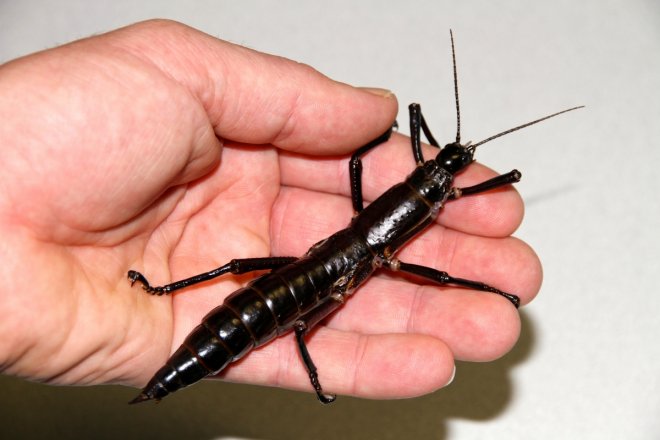
The officials in Australia are planning to wipe out "invasive rats" on Lord Howe Island to bring back a "native insect" which was once thought to be extinct.
Dryococelus australis, also known as tree lobster or Lord Howe Island stick insect and nicknamed as "the land lobster" has been found from Balls' Pyramid, an Australian Island in 2001. The officials tested the newly found specimen of the 'once extinct' species with museum specimens of original Lord Howe Island stick insect to find that they are of same species.
Mikheyev, who led the research published in the journal Current Biology said, "We found what everyone hoped to find, that despite some significant morphological difference, these are indeed the same species."
The authorities had declared the tree lobster as extinct by 1960. Rats which were introduced to the island after a shipwreck of steamship Makamba in 1918 led to predation of the insect. The tree lobster along with five bird species and 12 other insect species were dined by the rats to extinction.
The scientists had earlier thought that the tree lobsters survived only on the Lord Howe Island. Land-dwelling mammals were absent on the island which made a safe haven for them. The lobsters did not have wings and were of six-inch length. This made them vulnerable to the newly introduced predator rats.
The glossy-black adult insect used to camouflage in trees and bushes to evade predators. The younger insects are bright-green in colour. The adults dwell on trees during daytime and come out at night time to feed on shrubs, while the younger ones are active during the day.
"I imagine that maybe a decade from now, people will travel to Lord Howe Island and take night walks, hoping to glimpse this insect. In maybe 20 years, they could become a ubiquitous sight" said Mikheyev
A rock climbing ranger had found the insect in the Balls' Pyramid in 2001. Since then, the captive breeding programme has been done at the Melbourne 200 and other research facilities.
History of war against rabbits
The idea of mass termination of a species is not a new idea for Australia. The Australian government has been in a war against wild rabbits and hares for over a century now.
24 wild rabbits, which were introduced by Thomas Austin in his Estate near Geelong in Victoria, Australia in 1859 turned out to be predecessors of Australia's largest pest.
The rabbits which were meant to be a game for his hunts rapidly increased in their numbers and spread to other parts of Australia.
Australia started construction of one of the largest fence in the world in 1901 to control rapidly enhancing rabbit population. But the rabbits had been out of fencing area when the 1834 km fence which connected South Coast to North West Coast was completed. Soon a second layer of the fence of 1166 km connecting the first one was built. But this was not good enough to control rabbits from spreading across the Australian mainland.
The spread of rabbit has resulted in a loss of vegetation in the country. Soil erosion became frequent and reduced the land fertility. The deposition of sediments resulted in the destruction of the aquatic ecosystem. Grazing fields turned to be feeding grounds of rabbits which impacted the livestock and other native animals.
The agriculture sector of Australia is suffering from rabbit troubles. According to Pest Animal Control Cooperative Research Centre (PAC CRC), the country's economy faces a loss of up to $600 million due to rabbits.
According to PAC CRC reports, a series of deadly virus was from 1950 to control rabbit population. The introduction of myxomatosis virus in 1950 eradicated 90-100 percent rabbits in some areas.
Rabbit haemorrhagic disease virus (RHDV) released in 1996 by the government was also able to kill about 60 percent of the rabbits. A newly developed Korean strain of RHDV-K5 virus has been recently released in 600 sites of Australia from March 1. Farmers and environment groups took initiative to spread the virus to kill rabbits. The virus does not have a preventive vaccine.
The authorities are even collecting samples of dead rabbits for research. People are asked to contact concerned scientists if they find any dead rabbit.









